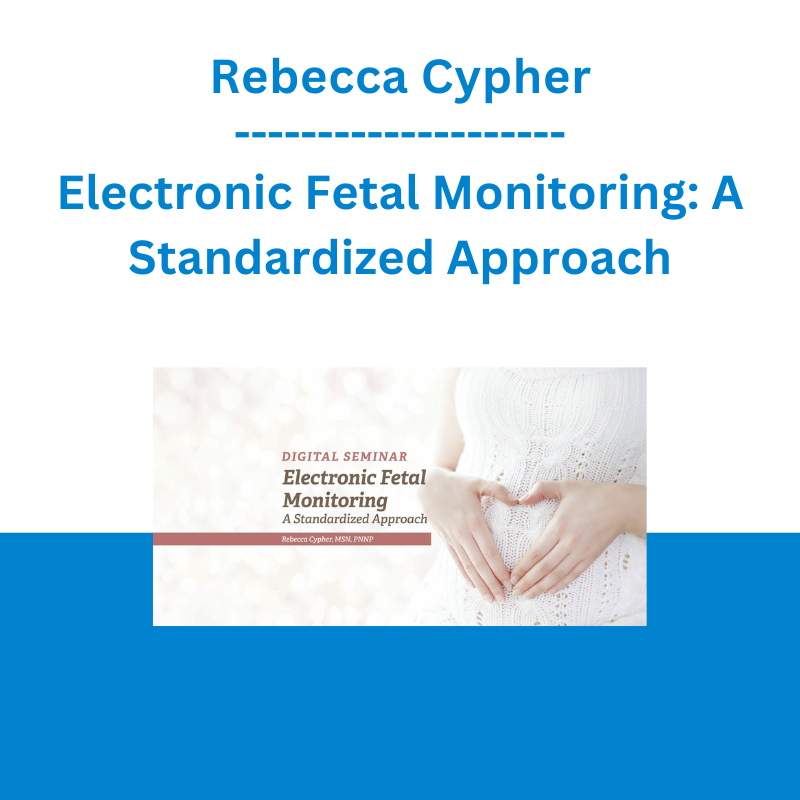*** Proof of Product ***
Exploring the Essential Features of “Rebecca Cypher – Electronic Fetal Monitoring: A Standardized Approach”
Speaker: Rebecca Cypher, MSN, PNNP
Duration: 1 Hour 54 MinutesFormat:Audio and Video
Copyright: Jan 03, 2023
Type: Digital Seminar
Description
Obstetric clinicians with their knowledge and skills, remain one of most important elements in high-quality intrapartum care. Unfortunately, after several decades of clinical use, many uncertainties continue to surround intrapartum monitoring including interpretation, management, and other related decision-making processes. When clinicians are not current in fetal monitoring or do have a firm grasp of basic concepts, there is a risk for adverse maternal and neonatal outcomes. This can have a significant negative impact on families and the healthcare system. Therefore maternal-fetal safety is of the utmost importance. Thus, continuous learning that includes contemporary research is fundamental for patient safety and for optimizing perinatal outcomes. An overview of fetal monitoring principles as well as updated research will be presented in this 2-hour recorded session.
Speaker
Rebecca Cypher, MSN, PNNP
Rebecca Cypher, MSN, PNNP, is owner of Maternal-Fetal Solutions, LLC, an independent consulting and education service, where she primarily focuses on assisting clinicians and hospitals to be change agents in the delivery of obstetric care. Her professional experience expands over 30 years in the perinatal arena, with 20 years on active duty, serving as a Nurse Corps officer in the United States Air Force, which included a wide variety of inpatient and outpatient obstetric settings in clinical and management positions. After military retirement, she worked as a perinatal nurse practitioner in a maternal-fetal medicine division focusing on obstetrical care and research. Rebecca served on the Board of Directors at the Association of Women’s Health, Obstetric and Neonatal Nurses (AWHONN) including one term as president. Rebecca is passionate about her profession and multidisciplinary education, with her attention devoted to evidence-based practice, clinical judgment, critical thinking, and collaboration within the healthcare team.
Speaker Disclosures:
Financial: Rebecca Cypher is the owner of Cypher Maternal-Fetal Solutions, LLC and a research nurse with the Amniotic Fluid Embolism Foundation. She receives a consulting fee from Clinical Computer Systems (OBIX) and royalties from Elsevier. Rebecca receives a speaking honorarium and recording royalties from PESI, Inc. She has no relevant financial relationships with ineligible organizations.
Non-financial: Rebecca Cypher is a member of the Association of Women’s Health, Obstetrics, and Neonatal Nurses (AWHONN); Sigma Theta Tau International; the Society of Maternal-Fetal Medicine, and the Society of OB/GYN Hospitalists. She additionally has professional affiliations with the American College of Obstetricians and Gynecologists Pregnancy and Postpartum Emergencies Task Force/Special Project and the Washington State Maternal Mortality Review Panel.
Objectives
- Define FHR characteristics using NICHD standardized terminology.
- Distinguish between the 3 elements of EFM standardization.
- Evaluate an organized, systematic ABCD approach to FHR management.
- Critique research related to Category II FHR management.
Outline
ABCD approach
- Assess the oxygen pathway a. Lungs, heart, vasculature, uterus, placenta, umbilical cord
- Begin corrective measures as previously outlined
- Clear obstacles to delivery
- Facility
- Staff
- Patient
- Fetus
- Labor
- Determine decision to delivery time
- Facility response time
- Staff
- Surgical, medical and obstetric considerations
- Other considerations (e.g., EFW, presentation)
Terminology
- What is it called
- Consensus statement by NICHD
- Adopted by AWHONN, ACOG, and ACNM
- Interpretation
- What does it mean
- What information does the FHR tracing provide regarding oxygen transfer
- Head compression, cord compression, uteroplacental dysfunction
- All decelerations have the exact same triggers
- Interruption of oxygen transfer from the environment to the fetus at one or more points along the oxygen pathway
- moderate variability and/or accelerations exclude ongoing hypoxic injury
- Management
- What do we do about it
- Corrective measures
- IV fluid bolus
- Lateral positioning
- Correct hypotension
- Decrease uterine activity
- Amnioinfusion
- Tocolytic administration
- Alter pushing technique
- Oxygen administration for maternal pulse ox <96%
- Introduction to ABCD approach to management
ABCD approach
- Assess the oxygen pathway
- Lungs, heart, vasculature, uterus, placenta, umbilical cord
- Begin corrective measures as previously outlined
- Clear obstacles to delivery
- Facility
- Staff
- Patient
- Fetus
- Labor
- Determine decision to delivery time
- Facility response time
- Staff
- Surgical, medical and obstetric considerations
- Other considerations (e.g., EFW, presentation)
“Intrapartum management of Category II FHR tracings towards standardization of care” 2013 article
- Algorithm
- Expert Opinions a. Not evidence based
- Definition of Significant Decelerations
- Key components of algorithm that are missing
- Precise cervical dilation
- When to notify primary clinician“
- A standardized approach for Category II fetal heart rate with significant decelerations: Maternal and neonatal outcomes”. 2018 article
- Prospective interventional trial: 29 hospitals
- Comparison between 2013 expert opinion and this trial algorithm
- Published results related to maternal and neonatal outcomes
- Only research conducted with a research protocol
- A standardized approach for Category II fetal heart rate with significant decelerations: Maternal and neonatal outcomes”. 2018 article
Target Audience
- Nurses
- Nurse Practitioners
- Physicians
- Physician Assistants
- Midwives
- Doulas
Please see the full list of alternative group-buy courses available here: https://lunacourse.com/shop/










 Oliver Velez - Essential Strategy Of Trade For Life
Oliver Velez - Essential Strategy Of Trade For Life  George Fontanills & Tom Gentile - Optionetics Wealth Without Worry Course
George Fontanills & Tom Gentile - Optionetics Wealth Without Worry Course  Toshko Raychev - Profit System + ITF Assistant
Toshko Raychev - Profit System + ITF Assistant  Money Miracle - George Angell - Use Other Peoples Money To Make You Rich
Money Miracle - George Angell - Use Other Peoples Money To Make You Rich  Sovereign Man Confidential - Renunciation Video
Sovereign Man Confidential - Renunciation Video  Matan Feldman - The 13-Week Cash Flow Modeling - Wall Street Prep
Matan Feldman - The 13-Week Cash Flow Modeling - Wall Street Prep  Team NFT Money - Ultimate NFT Playbook
Team NFT Money - Ultimate NFT Playbook  Fred Haug - Virtual Wholesaling Simplified
Fred Haug - Virtual Wholesaling Simplified  Julie Stoian & Cathy Olson - Launch Gorgeous - Funnel Gorgeous Bundle
Julie Stoian & Cathy Olson - Launch Gorgeous - Funnel Gorgeous Bundle  Emanuele Bonanni - My Trading Way
Emanuele Bonanni - My Trading Way  Akil Stokes & Jason Graystone - TierOneTrading - Trading Edge 2019
Akil Stokes & Jason Graystone - TierOneTrading - Trading Edge 2019  Simpler Trading - Bruce Marshall - The Options Defense Course
Simpler Trading - Bruce Marshall - The Options Defense Course  Chris Capre - Advanced Price Action Ongoing Training & Webinars
Chris Capre - Advanced Price Action Ongoing Training & Webinars  Trade Like Mike - The TLM Playbook 2022
Trade Like Mike - The TLM Playbook 2022  Greg Loehr - Advanced Option Trading With Broken Wing Butterflies
Greg Loehr - Advanced Option Trading With Broken Wing Butterflies  Cyndi Thomason - Profit First for Ecommerce Sellers
Cyndi Thomason - Profit First for Ecommerce Sellers  The Daily Traders – Exclusive Trading Mentorship Group
The Daily Traders – Exclusive Trading Mentorship Group  Erik Banks - Alternative Risk Transfer
Erik Banks - Alternative Risk Transfer  Dave Landry - Stock Selection Course
Dave Landry - Stock Selection Course  Matthew Kratter - Trader University
Matthew Kratter - Trader University  Wes Evans - Video Ad Mini-Course
Wes Evans - Video Ad Mini-Course  Danny Veiga - Facebook Ads for Complete Newbies
Danny Veiga - Facebook Ads for Complete Newbies  Lynn Waldrop - Lymphatic Drainage Flush MP3
Lynn Waldrop - Lymphatic Drainage Flush MP3  Forbidden Pattern The Gemini - Robert Anue
Forbidden Pattern The Gemini - Robert Anue  Christine Hassler - Healing Your Inner Child - Level One Virtual Workshop
Christine Hassler - Healing Your Inner Child - Level One Virtual Workshop  Forexmentor - Recurring Forex Patterns
Forexmentor - Recurring Forex Patterns  Lynn Waldrop - The Detox 7
Lynn Waldrop - The Detox 7  Lynn Waldrop - Autoimmune Series
Lynn Waldrop - Autoimmune Series  Scott Sonnon - TACFIT Mass Assault
Scott Sonnon - TACFIT Mass Assault  Lynn Waldrop - Love Myself, Love My Life Clearing Package
Lynn Waldrop - Love Myself, Love My Life Clearing Package